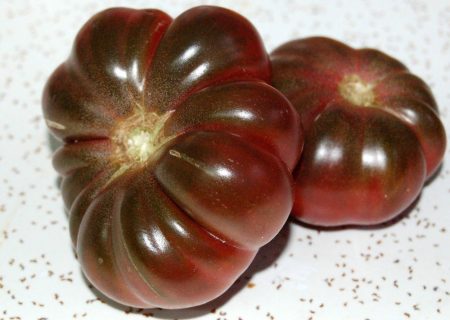
More recently, tomatoes with a violet color were considered an unprecedented miracle, and meeting such a curiosity in areas of gardeners was quite a rarity. However, today, thanks to the efforts of the originators, amethyst and black-violet tomatoes are successfully grown both in film shelters and in open ground, and their shade of existing varieties varies from soft purple to black-purple.
Similar tomato varieties were developed with the participation of a gene from one of the species of nightshade tomato, which is quite poisonous in nature but has increased resistance to diseases and temperature extremes. One of these fabulously beautiful varieties is the Purple Pumpkin Tomato.
Content
Tomato Sortotype Outline Purple Pumpkin
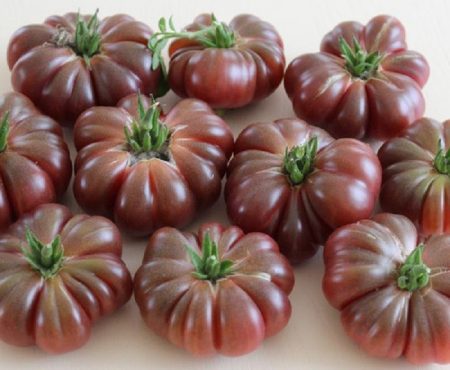
The variety is indeterminate, with an unfinished growth trend, but with its seasonal cultivation, the plant height reaches 1.7-2 meters. Mid-season, they give off their technically mature fruits 105-115 days after the appearance of the first seedlings, which reach weight parameters of 200-350 g and are distinguished by a purple-violet color. Fruits are large, flat-round, with a pronounced ribbing.
The bush is strongly leafy with leaves of a juicy green color. In a section, a tomato shows many seed chambers with juicy pulp, which is distinguished by an excellent tomato-fruit finish. Yield indicators of purple pumpkin are quite good and there are harvests of tomatoes from one bush of about 3.5-5.5 kg.
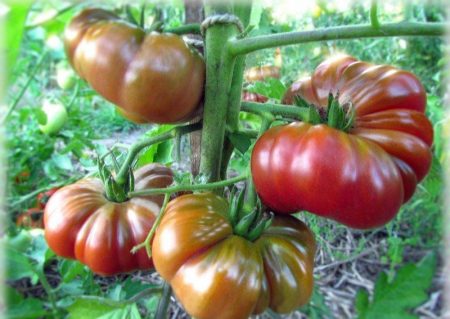
Features of cultivation of Purple Pumpkin
Tomatoes Purple pumpkin is successfully cultivated in many regions of the Russian Federation, Moldova and Ukraine, but most of all they work out when grown in the middle lane and in areas with a rather warm climate.
Most preferred is their cultivation in open ground, since the color saturation and the content of vegetable glycoside anthocyanide, which has a therapeutic effect on the human body, depends on bright sunlight. This element strengthens blood vessels and reduces capillary fragility.
Purple pumpkin is a variety that, when harvested, gives offspring all parental characteristics. Therefore, you can collect the grains of this tomato on your own, planting this tomato wonder at their sites for more than one season. Seeds are selected from ripened fruits, washed thoroughly under running water and dried.
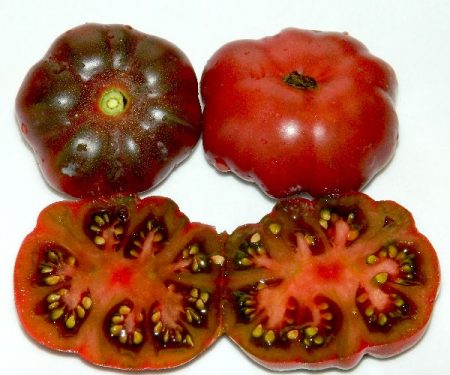
Before sowing tomatoes, which falls on the second or third of March, containers with soil are brought into a warm room. It is advisable to purchase soil mix for seedlings in specialized stores. Before planting, seeds must be sanitized and stimulated. To do this, the seeds are soaked for 30-40 minutes in a weak solution of manganese potassium at the rate of: 0.01 g per 1000 ml. Then the seeds are washed under running water and immersed in any growth stimulator for 10-12 hours. After drying, the grains are ready for planting. The soil in the containers must be moistened, the seeds spread out at a distance of 1.5 cm by 1.5 cm, deepened by the same amount and covered with soil.
Containers with sown tomato seeds are covered with newspaper or polyethylene and placed in a dark, warm place.After a few days, the first loops of seedlings will begin to peck. After their appearance, the covering material is removed, the room temperature decreases by several degrees, and containers with seedlings are installed in the most lit place. After growing 2-3 real pairs of leaves on tomato seedlings, young plants spawn in separate pots, trying to deepen each as much as possible into the soil, in no case with this action, filling the root neck.
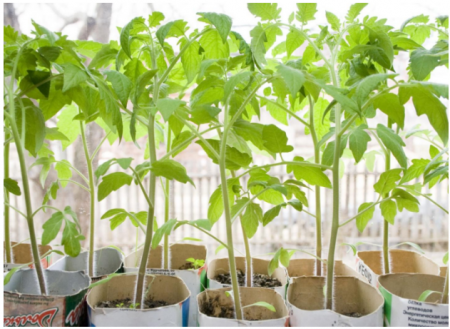
When establishing positive night temperatures in the second or third May decade, seedlings are planted in open ground, previously hardened for 7-10 days. In order for the fruits of the Purple Gourd to acquire a saturated bright color during the growing season, the soil before planting seedlings must be prepared in advance by adding to each well:
- 25 g of superphosphate;
- 30 g of potassium;
- 20 g nitroammophoski;
- humus;
- 1 glass of ash.
Throughout the tomato growing season, it is necessary to carry out all the appropriate agricultural practices, which include: tying up to trellises, forming a bush in one or two stems, pinching, watering with warm water, feeding and feeding. Fertilizing under tomatoes must be applied 3 times per season, using special complex fertilizer in the periods:
- full survival of seedlings;
- the formation of flower brushes;
- pouring fruit.
Diseases and Pests
All tomatoes with a violet color, including the Violet pumpkin, are characterized by increased resistance to many pathogens such as late blight, fusariosis, verticillosis. However, especially in rainy seasons, plants may be affected by some rot. Therefore, during the season, in order to prevent tomatoes, it is necessary to treat tomatoes once or twice with copper-containing preparations.
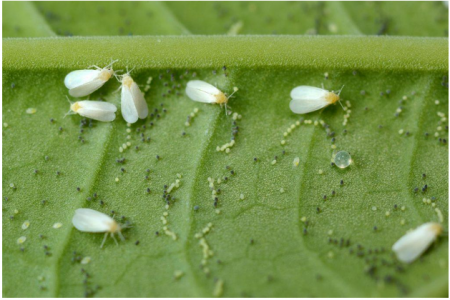
Of the pests, the greatest danger to the Violet pumpkin is the whitefly, whose offspring develops at a frantic speed when dry and hot summers are established. Oppercot and Actara preparations, diluted according to the instructions, are used to neutralize it.
Reviews and application of tomato Purple pumpkin
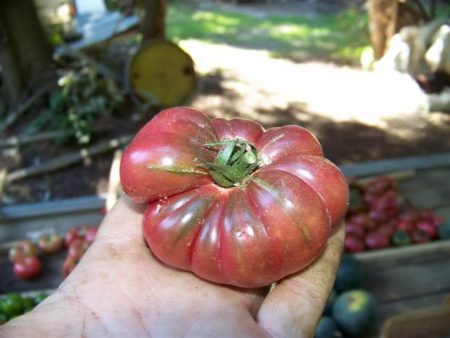
After growing this sortotype in their plots, many gardeners complain that their tomatoes did not turn purple, but only acquired a mauve. This is due to the fact that during the cultivation of tomato agricultural practices were not observed, and the soil was not sufficiently fertilized. In addition to this unpleasant fact, many gardeners were very pleased with the Violet pumpkin due to its resistance to pathogens, taste and decorativeness.
For canning in general, with home-made preparations, Purple pumpkin is completely unsuitable, but it produces good juice, pasta and sauces that differ in their original shade and pleasant fruity-tomato flavor.




 Low-growing tomatoes, without pinching: 5 of the most delicious varieties
Low-growing tomatoes, without pinching: 5 of the most delicious varieties Why tomato seedlings grow poorly
Why tomato seedlings grow poorly We grow a tomato in a shell
We grow a tomato in a shell Growing tomatoes without watering according to the method of Kazarin
Growing tomatoes without watering according to the method of Kazarin